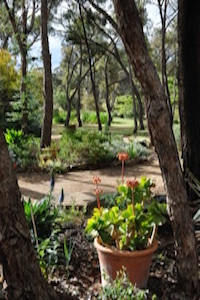Garden History



‘GARDEN OF LIXOURI’ – A SHORT HISTORY
Our property is named after the village of “Lixouri” on the Greek island of Chephalonia. We spent 10 months in Greece in 1964 teaching English and then lived in the UK until 1968 travelling around for 2 months each year in an old Bedford van. We visited most of the European countries through Russia to the Black Sea to Poland, East Germany, Bulgaria etc. down to Turkey and Greece. We returned to Australia at the end of 1968 by driving our van overland through the Middle East to Nepal where we sold our van and continued on home by ship from Singapore.
The Castlemaine district was the first area we looked for a piece of land. We had owned a sports car in our early 20s and loved the drive to Castlemaine - the history, the windy roads, the stone walls separating the paddocks (now mostly gone) and the wonderful feel of another era.
However, it was the love of the Mediterranean, the people, the way of life and Mediterranean trees and plants that were the inspiration for our home and garden “Lixouri”
We bought 20 acres in Barkers Creek and began building our two-storey mud brick house in 1983. It was built, painfully slowly at times, by Max and our friend Ian Blunck over two decades. We were keen to be self sufficient. We are totally reliant on solar power and use a back up generator occasionally in winter. We use a slow combustion stove for cooking and hot water as a back up and heat the house via hydronic heating panels installed throughout the house.
In 1981/82 we planted the olive grove of approximately 230 trees (varieties Baruni, Califorian Queen and the Italian variety, Fratoia flanking the gravel driveway was planted in 2001. 1981/82 were two of the driest years on record and we (with the help of child labour!) watered the trees by bucket to keep them alive.
Between the house and garage dividing the front and back gardens, is a tall curved wall topped with a tiny belfry. Entry from one into the other is through a beautiful hand wrought iron gate by local sculptor Trefor Prest. In 2005 a small porch was added to the back of the house with a balcony enclosed by a wrought iron balustrade. We love these additions to the house and garden as it reinforces the illusion that we are somewhere in the Mediterranean.
On sunny mornings coffee on the balcony is a regular event.
The last crop of olives produced 125 litres of beautiful oil. However, a huge number of trees around the district were infected with black scale and most growers had a small crop that year. We use an amino acid and seaweed extract spray to help the trees fight off the scale and this year all the trees are covered in flowers and we are hoping for a good crop in May/June 2015.
THE GARDEN
When we bought the land there was a tiny dam just below where we wanted to build the house. It was important to have the house near water and the dam was enlarged. In accordance with permaculture principles, Max buried water pipes under the garden beds and driveways so that every drip of run off ended up in the dam below.
The tiny dam is now a lovely watery space backed by paperbarks, almond and blue gums etc. surrounded by yellow water iris in Spring. A wooden jetty juts out over the water and is a great place to sit on a summer evening.
The garden consists mainly of Mediterranean plants and trees. A large arbour of old entwined wisteria and Cherokee rose in front of the house help keep the house cool in summer. The feeling of being in Italy or Greece is heightened by large terracotta pots placed throughout the garden amongst a large variety of pencil pines, deciduous trees, (Oaks, White Judas tree, Lime green flowering Albitzia, Chinese pistaccio, Japanese Pagoda tree, Manchurian pear, Medlar, dogwood, banksias) clipped cistus, euphorbias, artemesias, echiums, and many, many more. Most are drought hardy.
Sandstone terraces, gravel paths and old brick and sandstone steps lead down through the garden beds and terraces to the dam and into the olive grove. Garden beds and gravel paths wrap around to the back of the house, mud brick garage (used as a gallery when we are open), Margaret’s studio and pond and, finally, the vegie garden. Gardening can be frustrating in Central Victoria. For the most part, the soil is poor and rain unpredictable.
For approximately 15 years after the early 80s drought, the weather in Central Victoria was typical of the Mediterranean where the seasons were short but clear. Hot dry summers, wet cold winters but with lots of crisp sunny days, Spring, cool but sunny with showers and rainy autumns but also crisp and sunny. This gave the plants and trees time to put their roots down deep. Perfect for growing Mediterranean plants! However, the long range weather forecast for rain in the next few months does not look good and although we had quite a bit of soft gentle rain over this winter, there was little runoff into dams and many are already getting low. However, we gardeners always seem to remain optimistic and have developed all sorts of ways of protecting their precious gardens by, to name a few, creating shade, mulching heavily, planting drought tolerant plants, and watering in the cool of the day.(and keeping our fingers crossed!)
Thank you so much for visiting our home and our garden. We hope you have enjoyed your visit.
Max and Margaret Beyer




